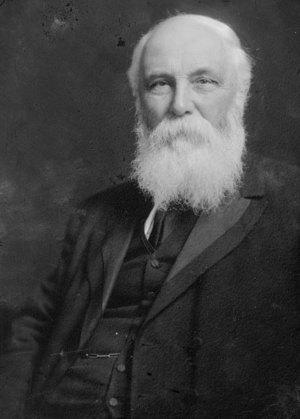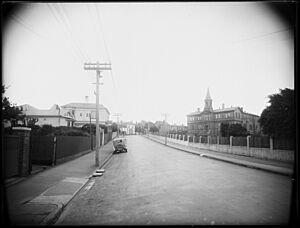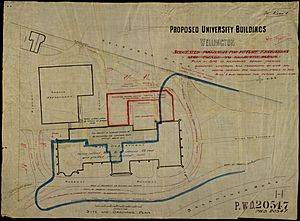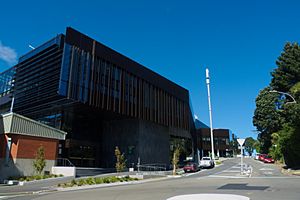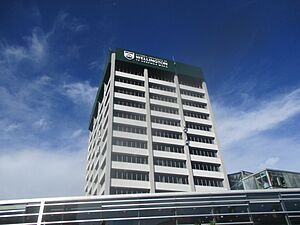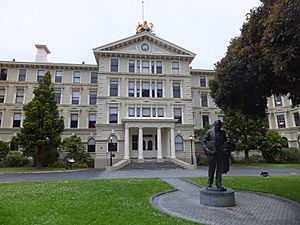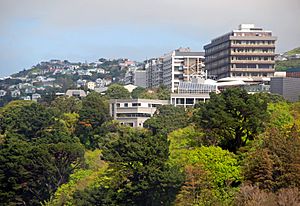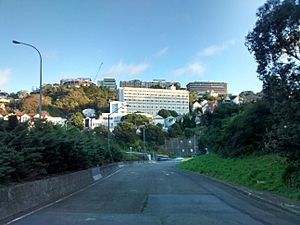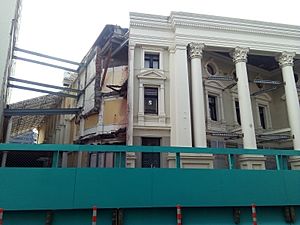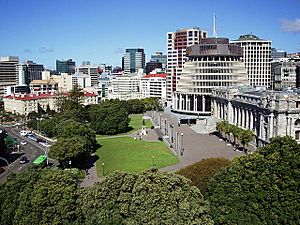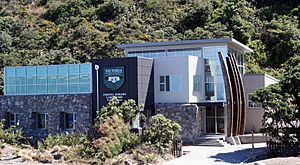Victoria University of Wellington facts for kids
|
Te Herenga Waka (Māori)
|
|
 |
|
| Motto | Latin: Sapientia magis auro desideranda |
|---|---|
|
Motto in English
|
Wisdom is more to be desired than gold |
| Type | Public |
| Established | 1897 |
|
Academic affiliation
|
ACU, AACSB, AMBA, EQUIS |
| Endowment | NZ$83.6 million (31 December 2021) |
| Budget | NZ$460.5 million (31 December 2021) |
| Chancellor | Alan Judge |
| Vice-Chancellor | Nic Smith |
|
Academic staff
|
1,147 (2021) |
|
Total staff
|
2,329 (2021) |
| Students | 23,090 (2021) |
| Location |
,
New Zealand
41°17′20″S 174°46′06″E / 41.28889°S 174.76833°E |
| Campus | Urban |
| Student magazine | Salient |
| Colours | Green and white |
Victoria University of Wellington (Māori: Te Herenga Waka), also known as "VUW" or "Vic", is a public research university in Wellington, New Zealand. It was started in 1897 by a special law from the Parliament. For a while, it was part of the larger University of New Zealand.
The university is well-known for its courses in law, arts, and some science subjects. It offers many other courses too. Most first-year courses are open to everyone. However, getting into the second year of some programs, like law or engineering, can be harder.
Victoria University has a strong reputation for its research. It was ranked very highly in New Zealand for research quality in 2012 and 2018. Globally, it was ranked among the top 250 universities by the QS World University Rankings in 2020.
Contents
History of Victoria University
Victoria University of Wellington was first called Victoria University College. It was founded in 1897. The name honored Queen Victoria on the 60th anniversary of her becoming queen. In 1961, the University of New Zealand was dissolved. At that point, Victoria University of Wellington, or "Vic," began to award its own degrees.
How the University Started
In 1868, the New Zealand government passed a law to help set up universities. This law also created scholarships for students to study in Great Britain. Soon after, the University of Otago was founded, followed by Canterbury College.
Later, in 1878, a special group looked at higher education in New Zealand. They suggested creating four university colleges, including one in Wellington. This idea was delayed a bit due to money problems. However, in 1882, the parliament passed a law for Auckland University College.
As Wellington grew, and the economy improved, the idea for a college there became stronger. Robert Stout, who was the Premier and later the Chief Justice, was a big supporter. He believed a college in Wellington could be great for studying law, political science, and history.
Founding the College
In 1897, the Premier, Richard Seddon, decided it was time to establish a college in Wellington. He had just received an honorary law degree from the University of Cambridge in Great Britain. He thought creating a college would be a good way to celebrate Queen Victoria's Jubilee year.
When he introduced the Victoria College Bill, Seddon said it was clearly needed. The college would be managed by a council of 16 people. Their first meeting was held on May 23, 1898.
First Professors
The first professors at Victoria College were:
- John Rankine Brown – Professor of Classics (ancient Greek and Roman studies)
- Hugh Mackenzie – Professor of English language and Literature
- Thomas Easterfield – Professor of Chemistry and Physics
- Richard Cockburn Maclaurin – Professor of Mathematics
Early Days of Learning
For its first ten years, Victoria College didn't have its own buildings. Classes were held at Wellington Girls High School and another school building.
The professors worked to create a special identity for the college. In 1902, they chose the motto "Sapientia magis auro desideranda," which means "Wisdom is more to be desired than gold." In 1903, the college got its own badge and colors: dark green and gold. These colors were inspired by the gorse plants on nearby Tinakori Hill.
The college also planned to start a law program. They wanted it to be the best in the country. They hired more professors, including George von Zedlitz for modern languages and Harry Borrer Kirk for biology.
Kelburn Campus Development
The university council looked at a 13-acre site for a permanent campus in 1889. This site was popular, but getting the land was difficult. In 1901, a wealthy farmer named Charles Pharazyn offered to donate money if the college was built on a hilly 6-acre plot in Kelburn. This was convenient because Pharazyn also had a financial interest in the Wellington Cable Car, which was being built nearby. The Cable Car still helps students get to the university today.
Construction began in 1902. The main building was designed in the Gothic Revival style. The governor of New Zealand, Lord Plunket, laid the foundation stone on August 27, 1904.
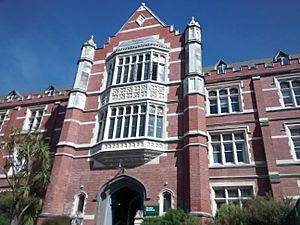
The building opened on March 30, 1906. It was named after Thomas Alexander Hunter, a respected professor. Over time, more parts were added to the building as the college grew.
University Growth
In 1960, a branch of Victoria University was opened in Palmerston North. This branch later joined with Massey College and became Massey University in 1964.
Victoria University has grown beyond its first campus in Kelburn. It now has campuses in Te Aro (for Architecture and Design) and Pipitea (near Parliament, for Law and Business). The university also has research centers in Lower Hutt and a creative center in Miramar. In 2015, Victoria opened a new campus in Auckland to meet growing demand.
Name Change Discussion
In 2018, there was a discussion about changing the university's name to "University of Wellington." The Vice-Chancellor, Grant Guillford, said this would help avoid confusion with other universities named "Victoria" around the world. The university council agreed to this idea and also decided to use a new Māori name, Te Herenga Waka.
However, many people, including students and former students, strongly disagreed with the name change. Out of 2,000 public comments, 75% were against it.
On September 24, 2018, the university council voted to change the name. But on December 18, 2018, the Minister of Education, Chris Hipkins, said no. He explained that the change didn't have enough support from staff, students, or alumni. In May 2019, the university council decided not to fight the Minister's decision.
Even though the name didn't officially change, the university has started using "Wellington's University" in many of its materials. They also changed names of some departments to include "Wellington Uni-Professional." In 2021, the university spent money on a new sign that highlights the word "Wellington."
Financial Challenges in 2023
In May 2023, the university faced financial difficulties. Vice-Chancellor Nic Smith announced a significant budget shortfall. This was mainly due to fewer students enrolling and less government funding. The number of students dropped by over 2,600 from 2022 to 2023.
To deal with this, the university planned to reduce staff numbers. However, in June 2023, the New Zealand Government announced more funding for universities starting in 2024. This extra money helped the university save some of the planned job cuts. In October 2023, Victoria University also started selling some properties to help with its finances.
Campuses and Facilities
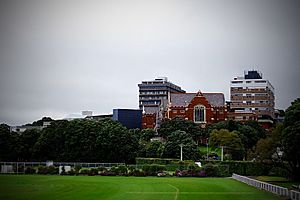
Victoria University of Wellington has three main campuses in Wellington city. It also has a smaller location in Auckland.
Wellington Campuses
- The main campus is in Kelburn, New Zealand. It overlooks the city center. This is where the Faculties of Humanities and Social Sciences, Science, Engineering, Education, and Health are located. It also has the main library, administrative offices, cafes, a bookstore, health services, childcare, and a sports center. The Victoria University of Wellington Students' Association is also here.
- The Pipitea campus is home to the Wellington School of Business and Government and the Faculty of Law. It's located near the New Zealand Parliament Buildings. This campus has its own libraries for business and law students.
- The Te Aro Campus houses the Wellington Faculty of Architecture and Design Innovation. It has a special library for architecture and design.
Auckland Location
The School of Business and Government offers some courses at its Auckland location, which is in the city center.
Other University Facilities
The Victoria University Coastal Ecology Laboratory helps with research on marine life and coastal environments. It's located on Wellington's south coast.
The Miramar Creative Centre is near the Wētā Workshop buildings. This center helps students get experience and connect with New Zealand's film, animation, and game design industries.
University Library
The university library started in 1899. Its collections are spread across four locations: Kelburn Library, Law Library, Architecture and Design Library, and Commerce Library. The library also has many digital resources, including e-books and online journals.
The library holds about 1.3 million printed books. It also provides access to 70,000 online journals and 200,000 e-books. It is one of only three libraries in New Zealand that officially stores documents from the United Nations System. The J. C. Beaglehole Room keeps special historical documents and rare books.
The New Zealand Electronic Text Centre (NZETC) is a digital library with important New Zealand and Pacific Island texts. The library also has online places where the university's research is shared freely.
Campus Improvements
Te Huanui and 320 The Terrace
In 2014, the university bought the abandoned Gordon Wilson Flats building. The university wanted to use the site to create a link between the city and the Kelburn campus.
There was a big discussion about whether to keep or demolish the flats. Some people wanted to keep them because of their architectural history. Others wanted them removed because they looked run-down. In 2016, the city council approved demolition, but a court later said the building's heritage status should remain.
In 2018, students used special technology to create a virtual reality model of the flats. This allowed people to explore the building as it was and how it looked then.
In 2020, Victoria University shared plans for "Te Huanui." This plan involves demolishing the Gordon Wilson Flats (but keeping nearby McLeans Flats). The area would become a new entrance to the Kelburn campus, with an outdoor plaza and new teaching spaces. It would also include a pedestrian and elevator link up to the campus.
National Centre for Music
In 2019, Victoria University, working with the New Zealand School of Music, signed an agreement to create a new National Music Centre. This center will be located in the Wellington Town Hall once its renovations are finished.
Ngā Mokopuna
Ngā Mokopuna, also known as The Living Pā, is a new development at the Kelburn campus. It involved removing old buildings and creating a new one based on sustainable design principles.
The building opened in late 2024. It was designed to be a "living building," meaning it meets very high environmental standards. It is one of only a few buildings in the world to have this special certification.
Organisation and Leadership
From 1938 to 1957, the main leader of the university was called the principal. Since 1957, this role has been called the vice-chancellor.
Here are some of the people who have led the university:
- Tommy Hunter, 1938–1951
- Jim Williams, 1951–1968
- Danny Taylor, 1968–1982
- Ian Axford, 1982–1985
- Les Holborow, 1986–1998
- Michael Irving, 1998–2000
- Stuart McCutcheon, 2000–2004
- Pat Walsh, 2005–2014
- Grant Guilford, 2014–2022
- Nic Smith, 2023–present
Professor Nic Smith became the Vice-Chancellor in January 2023.
The university is managed by its University Council, which has 20 members. These members include people elected by staff and students, and others appointed by the Minister of Education.
For New Zealand residents, most courses are open for entry. However, some courses, like Performance Music, require an audition. Also, getting into the second year of certain degrees, like Law or Criminology, requires selection.
The university also owns the New Zealand School of Music.
University Faculties
The university is divided into several faculties, which are like different schools for different subjects:
- Wellington Faculty of Architecture and Design Innovation
- Wellington School of Business and Government
- Wellington Faculty of Education
- Wellington Faculty of Engineering
- Wellington Faculty of Graduate Research
- Wellington Faculty of Humanities and Social Sciences
- Faculty of Law
- Wellington Faculty of Science
- Wellington Faculty of Health
Faculty of Law
The Faculty of Law is located in the beautifully restored Old Government Buildings. This location is very close to the Parliament and courts, which is great for law students. The faculty is highly ranked globally for law studies and is known for its strong research.
Research Centres and Institutes
Victoria University has more than 40 research centers and institutes. These are places where experts do special studies and research. Some of them include:
- MacDiarmid Institute for Advanced Materials and Nanotechnology
- Robinson Research Institute
- Ferrier Research Institute
- Malaghan Institute of Medical Research
- Victoria University Coastal Ecology Laboratory
- Centre for Strategic Studies New Zealand
- Adam Art Gallery
- Antarctic Research Centre
- International Institute of Modern Letters
- New Zealand India Research Institute
Academic Reputation
Victoria University of Wellington is highly regarded both in New Zealand and around the world.
In 2024, it was ranked among the top 250 universities globally in an overall ranking that combines different university lists. In the 2026 Quacquarelli Symonds World University Rankings, it was ranked 240th globally. The university also achieved high rankings in the Times Higher Education and Academic Ranking of World Universities lists for 2024 and 2025.
Student Life
Student Groups and Media
- Victoria University of Wellington Students' Association (VUWSA): This is the main student organization that represents students and offers services.
- Salient: This is the university's student magazine, where students can read news and articles about campus life.
Student Accommodation (Halls of Residence)
The university offers various places for students to live, called halls of residence. Some are managed by the university, and others are privately run.
- Victoria operated halls
- 222 Willis Apartments (students cook for themselves)
- Boulcott Hall (meals provided)
- Capital Hall (meals provided)
- Joan Stevens Hall (meals provided)
- Katharine Jermyn Hall (meals provided)
- Te Puni Village (meals provided)
- Weir House (meals provided)
- Willis St: Cumberland House (meals provided)
- Willis St: Education House (students cook for themselves)
- University Hall (students cook for themselves)
- University Hall: Whānau House (students cook for themselves)
- Privately operated halls
- Victoria House (meals provided)
- Everton Hall (students cook for themselves)
Notable Academics and Staff
- Bill Alington, architect
- James Belich, historian
- Doreen Blumhardt, education academic
- Jonathan Boston, public policy academic
- Mai Chen, public law lawyer
- Paul Callaghan, physical sciences academic
- Margaret Clark, political science academic
- Sally Davenport, management academic
- Lloyd Geering, religious studies academic
- Bill Hastings, chief censor and judge
- Robert Walker Hay FRSE, chemist
- Frank Holmes, economics academic
- George Edward Hughes, philosophy academic
- Simon Keller, philosophy academic
- Joanna Kidman, sociologist
- Allison Kirkman, sociologist
- Wendy Larner, social scientist, Provost
- Douglas Lilburn, music academic
- Richard Cockburn Maclaurin, mathematics academic
- Bill Manhire, author and poet
- Douglas Mews, academic and early keyboard specialist
- Paul Morris, religious studies academic
- Peter Munz, history academic
- Terence O'Brien, diplomat and academic
- Tipene O'Regan, Māori leader and education academic
- Vincent O'Sullivan, academic and poet
- Geoffrey Palmer, politician
- Matthew Palmer, law academic
- Pat Ralph, marine biologist; first woman at Victoria to be awarded a DSc
- Prof. James Renwick, climate scientist and science communicator
- Ivor Richardson, lawyer and academic
- Claudia Scott, public policy academic
- Kim Sterelny, philosophy academic
- Teresia Teaiwa, Pacific studies academic, author, poet
- Helen Tippett, Architecture academic, architect
- Matt Visser, specialist in general relativity
- Colleen Ward, cross-cultural psychologist academic
- Colin J. N. Wilson, volcanology academic
- Whatarangi Winiata, Māori leader and Professor of Accountancy
- John Chapman Andrew, foundation Vice Chancellor
- Warwick Murray, geography and development studies academic, musician
- Nicholas Agar, philosophy academic
Notable Alumni
Many famous people have studied at Victoria University of Wellington.
- Fleur Adcock, (MA) poet
- Barbara Anderson, (BA) author, poet
- Michelle Ang, (BCA, BSc) actor
- Sir Brian Barratt-Boyes, (BSc) heart surgeon
- Gankhuurai Battungalag, Mongolian diplomat
- Dr John Cawte Beaglehole, (BA, MA) expert on Captain Cook
- Harry J. Benda, (BA, MA) Czech-American Southeast Asian historian
- Teresa Bergman, (BA) singer-songwriter
- Hera Lindsay Bird (MA (Poetry))
- Sir Michael Hardie Boys, (BA, LLB) former Governor-General of New Zealand
- Sarah Billinghurst, (BA) artistic director at the Metropolitan Opera
- Dr Robert Burchfield, (BA) dictionary scholar
- Alistair Te Ariki Campbell, (BA, DipT) poet, novelist
- John Campbell, (BA(Hons)) New Zealand television personality
- Philippa Campbell, (BA) New Zealand film and television producer
- Jane Campion, (BA) Oscar-winning director/screenwriter
- Chea Serey, Director General of the National Bank of Cambodia
- Dr Helen Elizabeth Shearburn Clark (Rotman), Marine zoologist.
- John Clarke, (Honorary Doctor of Letters) creator of Fred Dagg
- Jemaine Clement, from Flight of the Conchords
- Nellie Euphemia Coad, (MA) teacher, community leader, author
- Baron Cooke of Thorndon, (LLB, LLM) former Law Lord
- Frank Corner, (MA, Honorary Doctor of Laws) New Zealand diplomat
- Andrew Digby, (PhD) Astronomer and ecologist, working in conservation
- Sir Thomas Eichelbaum, (LLB) former Chief Justice of New Zealand
- Sir Randal Elliott, (BSc) social campaigner, surgeon
- Bill English, (BA((Hons))), former Prime Minister of New Zealand
- Edith Farkas (1921–1993), meteorologist who measured ozone levels
- Gareth Farr, (BMus(Hons)) Composer, Percussionist
- Sir Michael Fay, (LLB) merchant banker
- John Feeney, documentary filmmaker
- Chris Finlayson, (BA, LLM) Attorney-General, MP
- Dr Alexander Gerst, (MSc) German astronaut
- Patricia Grace, (DipTchg, Honorary Doctor of Literature) author
- Paul A. Griffin, Distinguished Professor Emeritus at the University of California, Davis
- Prof Harry Hawthorn, (BA) NZ-Born Canadian anthropologist
- Hon. Georgina te Heuheu, (BA, LLB) MP
- Dr Fred Hollows, (BA) NZ-Born eye surgeon
- Don Hunn, (MA) State Services Commissioner
- Sir Jack Hunn, (LLM) New Zealand public servant
- Chris Hipkins, (BA) 41st Prime Minister of New Zealand
- Prof Witi Ihimaera, (BA, Honorary Doctor of Literature) author of Whale Rider
- Moana Jackson, (BA LLB) Māori lawyer
- Anthony Jennings, (B Mus) musician and academic
- Sir Robert Jones, (BA) property businessman
- Lloyd Jones, (BA) author
- Sir Kenneth Keith, (LLM, Honorary Doctor of Laws) international judge
- Roger Kerr, Executive director of New Zealand Business Roundtable
- Chong Kah Kiat, (LLB, LLM (Hons)) Former Chief Minister of Sabah state
- Hon. Sir Doug Kidd, (LLB) former Speaker of the New Zealand House of Representatives
- Dr Michael King, (BA, DLitt) historian
- Chris Kraus, (BA) American writer
- Sir George Laking, (LLB) New Zealand diplomat
- Sarah Leberman, Sport management academic
- Melanie Lynskey, Actress
- Dianne Macaskill, Chief Archivist
- Douglas R. MacFarlane (BSc), Chemist, researcher and author
- Prof Alan MacDiarmid, (BSc, MSc, Honorary Doctor of Science) winner of the Nobel Prize in Chemistry 2000
- Sabine Marcelis, Artist and designer
- Sir Jack Marshall, (BA, LLB) former Prime Minister
- Melissa Cristina Márquez, "Mother of Sharks," marine biologist
- James Jemut Masing, (BA) former Deputy Chief Minister of Sarawak
- Fiamē Naomi Mataʻafa, 7th Prime Minister of Samoa
- Sir Thaddeus McCarthy, (LLM) Court of Appeal judge
- Sir Alister McIntosh, (MA) New Zealand public servant
- Bret McKenzie, from Flight of the Conchords
- Dr Mary Morgan-Richards, (PhD) evolutionary biologist
- Sam Neill, (BA) actor
- W. H. Oliver, (MA) historian, poet, writer
- Teima Onorio, (BA) Vice President of Kiribati
- Simon O'Neill, M.Mus, (BMus(Hons), Honorary Doctor of Music) International Opera Singer
- Lorae Parry, (MA) Playwright and Actress
- Mark Paston (BSc) All Whites goalkeeper
- Tamatha Paul, (BA) Wellington City Councillor
- Sir Guy Powles, (LLB) New Zealand diplomat, first Ombudsman
- Dr Christopher Pugsley, military historian
- Maraea Rakuraku, (MA) writer
- Beverley Randell, (BA, TTC) author
- Sir Paul Reeves, (BA, MA) former Governor-General of New Zealand
- Dr Natalie Robinson, polar oceanographer
- Dr Jonathan Sarfati, (BSc(Hons), PhD) creationist author, Chess Champion
- Tuiloma Neroni Slade (LL.B.), Secretary General of the Pacific Islands Forum
- Conrad Smith, (LLB(Hons)) All Black 2004–2015
- Jacqueline Sturm, (BA, MA, Honorary Doctor of Literature) author
- Dr Bill Sutch, (BCA, MA) public servant
- Leslie Denis Swindale, soil scientist
- Sir Ronald Syme, (MA) classicist historian
- Sir Brian Talboys, (BA) former Deputy Prime Minister
- Peter Dengate Thrush (BSc, LLB) Chairman of ICANN
- Viran Molisa Trief, first female Solicitor-General and Supreme Court judge of Vanuatu
- Taika Waititi, (BA) Filmmaker, writer, and actor
- Fran Walsh, (BA, Honorary Doctor of Literature) Oscar winner, wife of film director Peter Jackson
- Dr Marilyn Waring, (BA(Hons)) feminist, former MP
- Clement Gordon Watson, (MA) editor, journalist, soldier
- Albert Wendt, (MA) author, Samoan poet
- Sir Maarten Wevers, diplomat and civil servant
- Dame Gillian Whitehead, (BMus(Hons), Honorary Doctor of Music) New Zealand composer
- Sir Richard Wild, (LLM) former Chief Justice of New Zealand
- Thomas Stafford Williams, (BCA), fifth Archbishop of Wellington, cardinal
- Nicola Willis, (BA(Hons)), MP
- Simon Wilson, (BA) editor of Metro magazine
- Dan Wootton, (BA) journalist and broadcaster
- Alison Wright, (BA) New Zealand athlete
- Martin Wylie, CEO of Slingshot
- Jack Yan, (LLB, BCA(Hons), MCA) businessman, publisher
- John Stuart Yeates (PhD (Botany)) academic, founding staff member of Massey University
Images for kids
See also
 In Spanish: Universidad Victoria en Wellington para niños
In Spanish: Universidad Victoria en Wellington para niños
- Tertiary education in New Zealand


